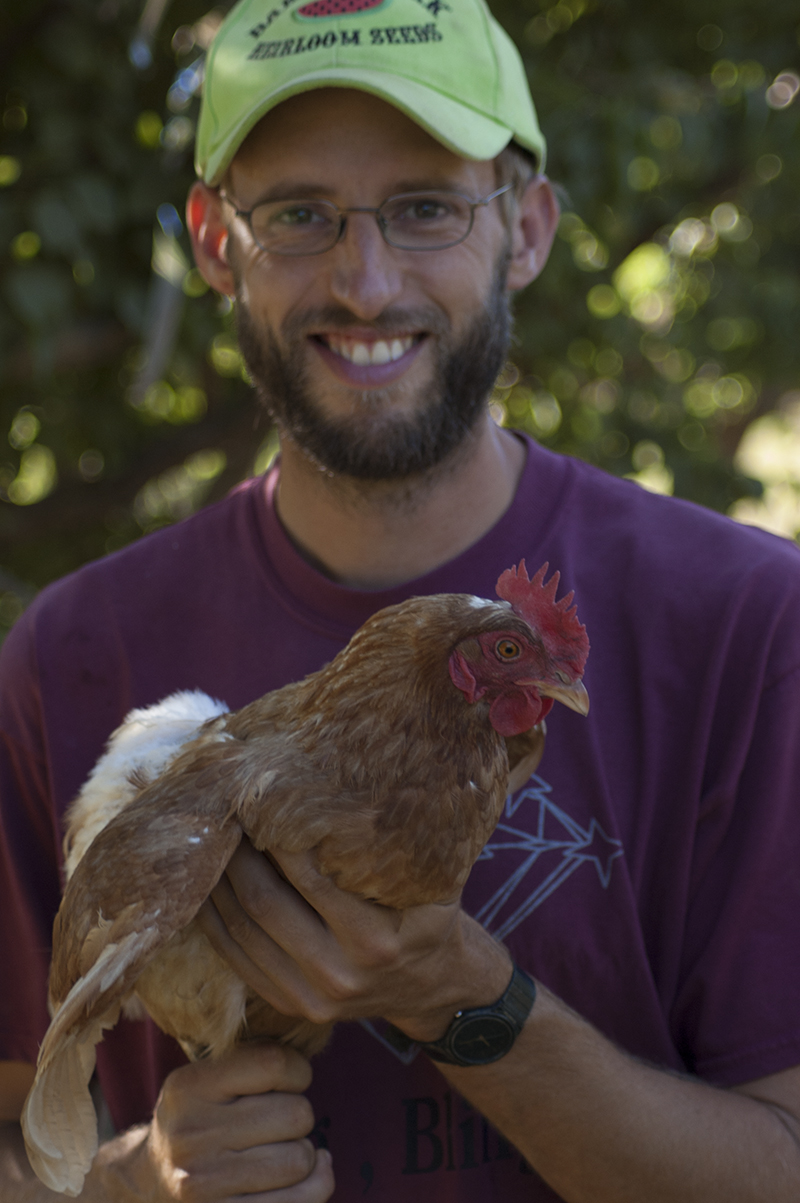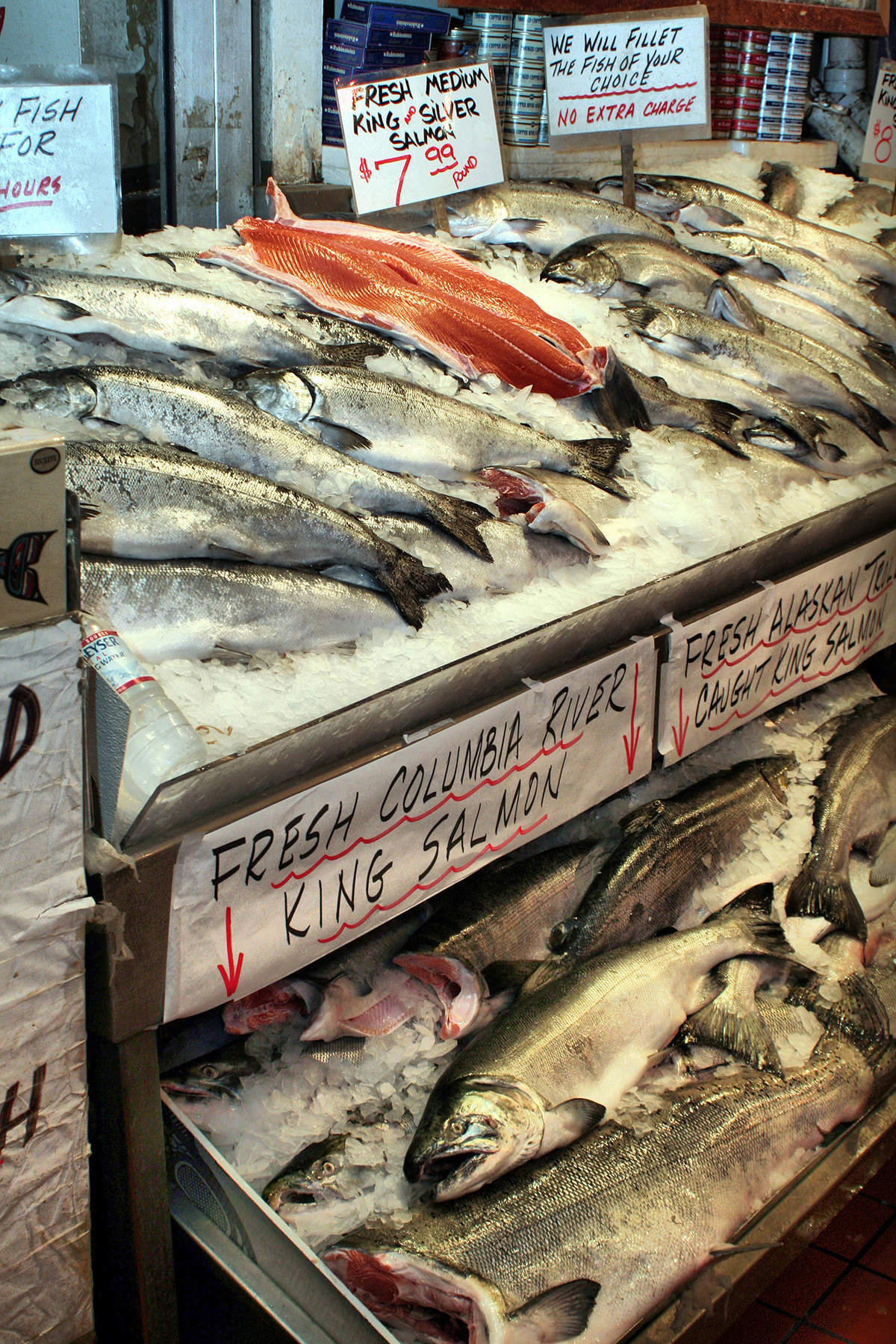Two weeks ago I arrived at the Broadway Farmers Market on Capitol Hill at 1 p.m. A sign at Early Bird Eggs read “Sorry! Sold Out.” I’m used to it. Every week I see similar signs at the Ballard and U District farmers markets.
Fresh eggs are my favorite local food. I love the bright sunflower-gold yolks, the cohesive texture of a just-laid egg-white, the rich, buttery flavor, and the knowledge that the chickens who laid these eggs are not cooped up in tiny cages, but scratching and foraging and improving the soil, out in the fresh air. At $5 to $9 a dozen, local free-range eggs can seem expensive, but their quality is so obvious that to me the cost is worth it. And apparently I’m not alone.
So the next I week got to the market at 11:15 a.m., 15 minutes after it opened. Early Bird Eggs’ blackboard said “Buy your eggs first. Limited Supply Today.” I handed over $12 and bought two dozen large brown, white, and pale blue eggs. Good thing I did. By the time I made it back to the booth 30 minutes later, the sign had changed. “Sorry! Sold Out.” The market had been open less than an hour.
Why, I wondered, is there a “limited supply” of local free-range eggs? Even at twice the price of a grocery-store dozen, farmers markets are always selling out of them. What are the economics of the local egg business? If there’s such a demand, why aren’t farmers producing more eggs? Or charging more for the eggs they have?
Until last year I bought my local free-range eggs from Biocento Farms at Madison Market/Central Co-Op. Then they suddenly disappeared. I called Biocento’s Soren Singel, whose farm is in Yakima, and asked him what happened. Singel was surprisingly candid: “There are no economics to it.”
The local egg business—for Biocento, at least—was not profitable at all.
Part of this is because Biocento is a small farm by design, and Soren is unable, or uninterested, to take advantage of economies of scale. “When I first started with the chickens,” Singel said, “I called up this chicken ‘guru’—a vet here in Yakima—to learn what I could, and he asked me ‘How many batches do you have?’ I didn’t even know what a batch was. He just laughed at me.”
In a so-called “conventional” system, a batch is 200,000 chickens—supposedly the smallest unit you can raise and still make a profit in a commercial setting. Singel had only 20,000 chickens, 12 acres, and a garage. “Profitable commercial chicken facilities,” Singel explained, “raise four to five batches a year, and they don’t buy chicks, they buy chickens that are already laying. Raising chicks to laying age is a separate business.”
Singel and other small-scale local egg producers like Early Bird Eggs do not use this type of facility. Not only is it contrary to their philosophy, but they want to use heritage breeds, for reasons that range from the birds’ beautiful feathers and their eggs’ striking blue and brown shells to preserving genetic diversity and the eggs’ rich flavor.
“But,” Singel continued, “heritage breeds “don’t produce as many eggs to begin with. You have to feed them for six to eight months before they lay, and it is difficult to sex them, so you end up feeding males for four months until they are big enough to be identified and culled from the flock.” Four months of feed costs a lot of money.
According to Singel, the cost of feed is significant in a truly free-range system. “Chickens that run freely in the pasture don’t lay as many eggs as if they’re confined. All the energy they spend running is energy they were not using to produce eggs. My girls had big muscles and lots of fun. I used to call them my little athletes!”
But like most athletes, chickens have their season. “You have to keep your chickens indoors and under at least 14 hours of artificial light in the winter to trick them into laying. This also costs money.” For Singel, that price was $800 a month. He also saw significant costs, in both time and money, in bringing Biocento’s eggs to market. “When I account for everything, it costs me $9 to produce a dozen truly free-range eggs. So you see, the consumer will not support what it costs us.”
But poor profitability was not the reason Singel stopped producing eggs. He was told he had to.
Several seasons ago, Singel planted berries at Biocento Farms. “What we learned,” Singel said, “is that the consumer’s idea of a happy farm with produce and livestock, chickens and pigs, is a fiction.” The Washington State Department of Agriculture sets strict regulations governing raising livestock or other animals on a farm and selling produce grown onsite. “The WSDA’s concern is that livestock could potentially contaminate the produce and pose a health risk to the consumer. So we got rid of the chickens. As long as we had them, we could not get a health permit to take the berries to market.”
Rawley Johnson of Early Bird Eggs has a slightly different story.
Johnson bought his first 500 chicks this past October. Because of the acreage, the distance between the fields, and the type of planting at Local Roots Farm, where Johnson also works and pastures his chickens, he’s able to integrate livestock with produce, which he considers essential to a healthy, diversified farm.
As he explains it, state and federal farming regulations are complex and in flux. The Food Safety and Modernization Act (FSMA), a huge piece of legislation which could have an enormous impact on the viability of small diversified farms, is in Congress now. In Washington state, the Good Agricultural Practices program (GAP) is trying to identify problems and define best practices for small diversified agriculture. In Johnson’s experience, safety guidelines depend on the size of the farm; the distance between livestock and vegetables; whether the farm sells wholesale as Biocento did or directly to the customers like Early Bird Eggs; and how crops that might be contaminated by livestock are raised. Lettuce and other vegetables grown on the dirt, for example, are considered more at-risk than, say, tomatoes, trellised off the ground and protected by a greenhouse.
Another important factor is how long fields rest after livestock use them. Currently, Johnson says, that time is between 90 and 120 days. But there is some concern about a provision in FSMA that would require a nine-month fallow period on fields used by livestock. “Not being able to use a field for nine months means I can’t make money from that field for a whole season.” During this fallow period, intended to protect against harmful contamination, the nutrients from animals that pastured there would leach out of the soil and likely need to be replaced with fertilizers. More important, farmers like Johnson would need more land to produce the same amount of produce. This could have a huge impact on the financial viability of small diversified farms, like Early Bird Eggs. “I know lots of small farmers who are holding their breath,” says Johnson.
Still, he thinks it’s important that small farms should not be exempt from common-sense food-safety practices. But what he doesn’t want is for regulations aimed at farms of a different scale to make small-scale farming untenable. He doesn’t want to get rid of his chickens or face a produce-vs.-livestock game. Instead of hard-and-fast regulations, Johnson advocates adaptable guidelines that could work with small farmers and their individual situations to achieve safe food and diversified farms.
Johnson means diversified not just in terms of plantings, but economically as well. As he sees it, a farmer needs to be able to offer something at the market throughout the season. “Eggs are seasonal. As the days get shorter and the weather gets hotter—unfortunately, when demand for eggs is the highest—chickens lay less, no matter how many chickens I have. But in an integrated farm, we have these beautiful fall vegetables coming in.”
“Right now,” he says with a hopeful look in his eye, “I’m looking for the right piece of land to plant vegetables and pasture my chickens,” which I hear as a vote of confidence in local eggs and small diversified farms in a climate where legislation leaves many unknowns.
* * * * *
Seattle Residents Raise Their Own Chickens
Increasingly, urban dwellers are choosing to raise chickens and get their own farm-fresh eggs. Leslie LaRue Whalley and her husband always had secret aspirations of living on a farm, so they built a coop instead, buying plans online from a guy in Kansas. “We let them roam around our backyard most of the day, which is about 4,000 square feet.They feast on bugs, grass, dandelions, and any food scraps we give them. Unfortunately, they ate all my kale I just planted. Apparently they’re big fans!”
Though their goal wasn’t to save money on eggs, Whalley admits the eggs are a big perk: “We did it purely for our own entertainment of raising something from a baby; watching it grow, knowing everything it eats, how it’s treated, has been really satisfying. And yes, the eggs are amazing!” But her favorite thing about having her own chickens? “I never realized how much personality chickens have. Spartacus is the most friendly and vocal, Lollie is shy but loves to be held, and Penny takes a daily dust bath and throws dirt all over herself. She’s also a big sunbather, and spreads her wings and legs out in a little-old-lady way. They follow me around the yard, and come running when I call. It’s a very unique form of stress relief and humor. When we have to get them back in the coop, my husband and I sometimes feel like we’re in a Benny Hill video. But I wouldn’t change a thing. They’re wonderful!”
Gwendolyn Elliott, on the other hand, did initially get her chickens for the eggs, though she and her boyfriend also wanted to see what it would be like to raise their own birds. Their flock of four is fed a diet of organic corn pellets, organic cracked grain, and lots of kitchen scraps. Elliott says the eggs “taste wonderful, and we use them all the time in baking, pickling, salads, all kinds of cooking.” (The upkeep does not in the end save them money, though.)
Their hens have a 480-square-foot run, separate from their backyard. The building of their coop is a funny story. “We actually had a 1984 VW diesel Jetta we traded with a carpenter who custom-built us a cedar coop. It has six nesting boxes, three on each side, and the roof over each side opens so you can clean the boxes and reach in and grab the eggs easily. There’s also a removable aluminum floor for easy cleaning, air vents, a removable ramp to get in and out of the coop, and sliding doors to secure them in at night. It’s up on stilts, and kind of looks like a chickie chalet.” NICOLE SPRINKLE
food@seattleweekly.com






